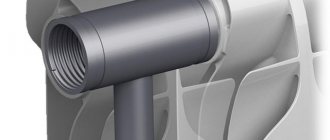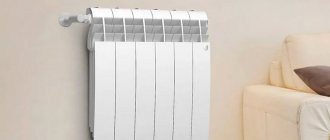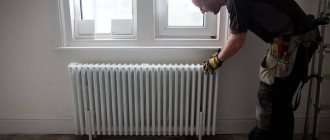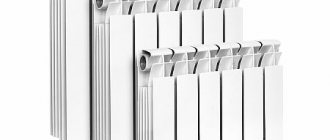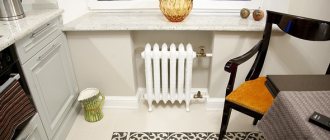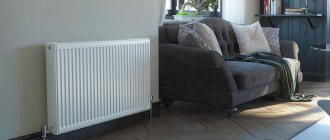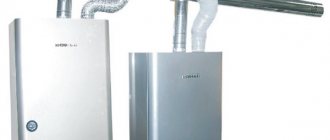Radiators from the Rifar company are a modern solution for heating in apartment buildings, taking into account the operating features of Russian heating systems. A characteristic feature of heating devices of this brand will be increased heat transfer, which will allow them to be installed even in large premises. At the moment, the company produces 2 main types of equipment: the Base line with the option of extending radiators with additional sections and the non-separable Monolit series with improved operating parameters.
To make it easier to choose Rifar radiators, a review of the most productive models has been compiled. Among them there are both economical devices and premium category devices. When compiling the rating, the purpose of the model, its advantages and disadvantages, expert assessments and user reviews were taken into account.
Difference between Rifar Base and Monolith radiators
The most important difference between both lines of radiators is their design features.
Rifar Base is a collapsible structure consisting of a different number of sections, the number of which depends on the calculated heating power. A monolith is a solid product with a predetermined heat capacity. The first can withstand pressure of hot water or antifreeze up to 30 atmospheres, the second - up to 150. Thus, Rifar Base radiators can be used in apartments or offices, Monolith - in premises of any purpose and thermal insulation. They are reliable, durable, easy to install, have a modern design and fully satisfy all consumer needs.
- Sectional models make it possible to complete the radiator with the required number of sections.
- For non-standard layouts, there are sectional models with a radius of curvature.
- If it is necessary to make a connection in a non-standard way, it is possible to select models with lower and upper types of coolant supply.
- All consumables supplied by Rifar are adapted for Russian engineering structures.
- Monolithic samples are ideal for installation in apartment buildings with frequent pressure drops in the heating system.
- Modern monolithic Rifar designs are suitable for all types of coolants.
- The reliability of the design and ease of installation have earned recognition among installation specialists, and the long service life allows you to forget about replacing the heating system for a long time.
The manufacturer values quality and works with reliable suppliers of its products, who can give a detailed description of each model and advise on any issues related to heat supply in the apartment.
Tips for choosing radiators
Before purchasing a suitable heating device, you should familiarize yourself with the product selection criteria:
- Heat dissipation power. The optimal power level for the apartment is calculated directly by a specialist. He will make the correct calculations of the square footage of the room, the number of windows, and the height of the ceilings. Only then is the required number of sections in the radiator determined.
- Pressure. When buying a radiator for an apartment connected to centralized heating, it is recommended to buy a durable device whose pressure will reach 40 atm. In private homes it is possible to use more affordable products.
- Design. There are 2 types of radiators - monolithic and sectional. Monolithic ones are suitable when the system experiences unstable pressure and strong water hammer. Sectionals are used more often, as they have an important advantage - you can always add or remove sections.
Radiator characteristics
Bimetallic heating radiators "Rifar" are intended for installation and use both in administrative buildings and in residential premises of houses and apartments. They are designed specifically for the local heating system with a certain pressure and coolant.
- The products are made of two metals - the inside of the coolant tanks is made of steel, and the body is made of aluminum. The case is the “face” of the product and gives the batteries neatness and elegance, since the panels have an enamel coating on top.
- The internal cavities for moving coolant are quite reliable and can easily withstand pressure of 30-40 atmospheres. And aluminum, in itself, is an excellent conductor of heat; when heated by steel parts, it transfers thermal energy well into rooms.
- When operating such radiators in an autonomous system, a large amount of coolant is not required - only 0.2 liters are needed for one section. Therefore, the circuit heats up very quickly, and it is quite possible to save money on heating large rooms. This parameter of batteries can easily be attributed to their positive qualities.
- The steel parts of Rifar radiators can easily withstand temperatures up to 130 degrees.
- Thermal output from each section is 180-200 W.
Sectional radiators
Each section of the bimetallic radiator consists of an internal steel part in the form of vertically arranged tubes, and aluminum plates are fixed on top, which provide an attractive appearance and serve as a source of heat transfer. The section is monolithic, the connections of individual segments are carried out by seamless welding using sealing materials. The inside of the steel core is coated with a thin layer of silver, which increases the product's resistance to corrosion and extends its service life. The aluminum body is located in such a way that it transfers heat to the external environment as much as possible, while the design is ergonomic and attractive, so the radiators look good in any interior.
In Rifar sectional radiators, the principle of energy conservation is implemented for the first time; the batteries can be equipped with heat sensors and thermostats, which reduces utility costs and allows you to achieve comfortable temperature conditions in the room.
Models of Rifar radiators, their disadvantages and advantages
The company has gained a leading position in the market of bimetallic radiators thanks to the constant modernization of equipment and the use of the most modern materials. Rifar radiators are manufactured in accordance with European standards, have an En 442 quality certificate, and they are guaranteed to withstand operating conditions in urban and private heating systems in Russia. Like all technical devices, these devices have their pros and cons, let’s look at them in more detail.
Colored Radiators Rifar
Flaws
Despite the fact that Rifar bimetallic radiators have good consumer performance, they are not without certain disadvantages. The main disadvantage of this company's heating devices is that they are not completely bimetallic. It is believed that full bimetal is much stronger and demonstrates greater heat transfer, but it all depends on the quality of installation and the build quality of the radiator itself.
Another drawback that Rifar batteries have is weak threads. On the forums you can find reviews about the problem and ways to solve it. To be fair, it is worth noting that almost any radiator model has disadvantages, so let’s move on to the advantages.
Advantages
Rifar radiators - technical specifications
The main advantage of Rifar radiators is their affordable price. This parameter is ensured due to the fact that Rifar is a Russian company and practically does not use expensive imported components in its products. The batteries are produced using the technology: “partial bimetal using spot welding,” which also significantly reduces the cost of production.
Rifar radiators - scope of delivery
The company offers its consumers a wide range of batteries for different modes of use, these include:
- models that operate only on a certain type of coolant, for example, only on filtered, soft water;
- Rifar batteries, which work equally well with tap water of any hardness;
- models working with antifreeze and water.
Alp
Bimetallic radiators of this series are distinguished by the smallest section depth - 75 mm. But this indicator does not affect the deterioration of heat transfer. Thanks to this, it is possible to install 14 sections simultaneously, which makes them indispensable when installing under wide window structures.
The center distance is 500 mm, the color according to the RAL palette is 9016 (white). Other technical data is shown in the table:
General disadvantages of Rifar products
The RIFAR Alum radiator is designed for use both in traditional heating systems and as an oil-fired electric radiator.
If you believe reviews published on the global Internet, bimetallic heating radiators from the Rifar company do not have very reliable threads. From time to time this leads to unfavorable consequences for the heating system, since the reliability of the components decreases.
It should also be noted that radiators of this brand can only be classified as partially bimetallic. If you ask any specialist who installs heating systems, he will confirm that completely bimetallic radiators are better. Correct operation guarantees long service life of partially bimetallic equipment.
Situations are common when an incomplete bimetal deserves the right to life, since the final system will not be used in any harsh conditions. Purchasing expensive products may not be justified, since all of its functionality will not be used. Why overpay when, all other things being equal, cheaper radiators will normally heat an apartment or house?
Rifar Monolit - reliable radiators that leave no chance for cold air
Heating radiators RIFAR Monolit.
Rifar Monolith branded radiators are characterized by one important feature - an innovative design that expands their technical capabilities. The main properties of the products allow them to cope with various operating conditions, even the most unfavorable ones
Appearance
Externally, Monoliths look exactly the same as aluminum radiator models. The advantage lies within. It is expressed in the following way - the heat carrier moves through channels made of steel. They are welded together in such a way as to form a single coolant flow path. The likelihood of leaks with Rifar Monolit 500 or 350 is reduced to almost zero.
Heat dissipation
As for thermal output, this figure is very high. This is achieved due to the geometry of heat-transmitting surfaces with increased fins. The material of manufacture, aluminum, also increases heat transfer.
Design Features
The design features of heating batteries of this brand provide a large number of other advantages. Which ones? For example, increased service life. The manufacturer provides a guarantee of a quarter of a century.
This fact speaks volumes, since not every company can guarantee such high durability of its products. The channels through which the coolant moves are made of steel tubes and are designed to be highly resistant to corrosion.
Thanks to high-precision processing of welds, there are no joints between radiator sections. Rifar Monolith batteries interact normally with various coolants. Regardless of which heating system (individual or centralized) this product is installed in, it will fully provide the required functionality. Even non-freezing liquids (antifreeze) can be used as a coolant.
https://youtube.com/watch?v=eJJmWX9BFbs
Strength
Due to the increased strength of Rifar Monolit connections, they can withstand pressures of up to 100 atmospheres. The test value for this value is slightly higher (150 atmospheres). The maximum temperature at which coolant is supplied is 135 degrees. Quite respectable values when compared with other offers on the domestic market.
Where can it be used?
Thanks to the professionally designed convective and radiant parts, Rifar Monolit radiators can be used in all types of premises - ordinary residential to school and medical. Installation does not require additional purchase of adapters for right-hand or left-hand threads. Standard connections ensure quick installation.
The number of Monolith sections ranges from 4 to 14. The cost largely depends on the type of product. Approximately Rifar Monolit 500 will cost approximately $19.3 per section. The model designated 350 costs a little less – $19. Feel free to round up to $20 or even more, as product prices often exceed those recommended by the manufacturer.
Rifar Monolit and SUPReMO
New generation Rifar bimetallic radiators with a monolithic design have become a real breakthrough in the field of creating reliable domestically produced heating radiators.
The steel core was first created using flash-butt welding technology, which was patented by the company’s engineers and has no analogues in the world. The solid steel body completely eliminates the possibility of leakage and is capable of withstanding hydraulic shocks in heating networks of over 100 atmospheres. The thickness of the walls of the tubes for the passage of coolant coincides with the thickness of the pipes in Russian systems; this thick layer is coated on the inside with an anti-corrosion compound and makes it possible to fill the system with any type of liquid.
The aluminum casing, which hides the internal structure, looks attractive, has no sharp corners, and thanks to its wide ribs, provides excellent heat transfer and quick heating of the room. Factory painting in several layers using a special heat-resistant material holds up well and does not require additional costs to maintain an attractive appearance.
To save money and maintain a comfortable temperature, monolithic structures are equipped with thermostats and control sensors.
Due to the monolithic structure, this type of Rifar radiator does not provide for additional sections or modifications, but is available with a large number of variations from 4 to 14 fins.
Depending on your preferences, you can choose one of two series of monolithic rulers.
- The MONOLIT series is similar to the bimetallic designs of sectional radiators, but this similarity is only external. A durable one-piece steel body is hidden inside, the tubes of the coolant circulation system are located vertically, and the small angle of inclination of the aluminum fins ensures high heat transfer parameters. The complete absence of sharp corners and heat-resistant coating facilitates the maintenance of the radiator, and the ability to choose a lower or upper connection type expands the operating conditions in various networks. Radiators manufactured later than 2011 can work with antifreeze, as indicated in the instructions for the device. Rifar guarantees the preservation of the technical characteristics of the monolithic structure of this series for 25-50 years, depending on the model.
- The SUPReMO series is the embodiment of the dream of exquisite design, safety and excellent thermal properties. The aluminum SUPReMO case is a one-piece box, thanks to which the radiator looks attractive and eliminates the possibility of accidental injury. The beveled side surfaces increase heat transfer and allow you to quickly warm up a large room. The inner surface of the steel case is covered with an additional protective layer, which increases resistance to alkaline environments and makes it possible to use coolant oils and antifreeze liquids. SUPReMO radiators are adapted to upper and lower connection types, suitable for left-handed and right-handed heating systems.
All designs are supplied complete with consumables adapted to the specified diameter of the heating pipes. Monolithic radiators are considered the best of all heating devices on the market today, and the reliability of the Rifar company has been proven by many years of successful experience and reviews from satisfied customers.
Types of radiators
Radiators come in a variety of sizes
Different radiator models also have their own characteristics, and differ mainly in their dimensions and center distance. The size of the battery, in addition, directly affects its heat dissipation. To familiarize yourself with the specific parameters of various models, you can look at the table compiled by the manufacturer.
| Model | Center distance in mm. | Depth in mm. | Height in mm. | Width in mm. | Weight of each section. | Heat flow rating of one section in W. |
| Base 500 | 500 | 100 | 570 | 79 | 1,92 | 204 |
| Base 350 | 350 | 90 | 415 | 79 | 1,36 | 136 |
| Base 200 | 200 | 100 | 261 | 79 | 1,02 | 104 |
| Alp 500 | 500 | 75 | 570 | 79 | 1,50 | 191 |
So, the center distance affects the dimensions of the battery. For example, “B-200” is well suited for a small room, and “B-500” will look great in a room with a large area. If the square footage of the room is large, and even with large window openings, then to heat it you need to purchase the “A-500” model, which has excellent heat transfer.
Models are also divided according to their connection type. Some of them have special pipes for lower connections, and they can easily be installed in an already installed heating circuit. The cost of these radiators is slightly higher than with a conventional insert system. But it should be noted that these models have much more advantages, both from a technical and aesthetic point of view.
Bottom connection diagram for Rifar radiators
So, the advantages of such Rifar radiators:
- The aesthetics of the bottom connection is that all pipes run along the floor and do not rise above the baseboard.
- Easy and quick installation - installation will not take much time and effort, and for the Rifar-monolith model you will not even need valves to connect the sections, which will allow you to save money.
- Each radiator model is patented and has a technical passport.
- Radiators with outlets for connection from below are suitable for any coolant, including antifreeze.
- The built-in thermostat allows you to control and set the temperature in the battery as required at the moment.
Possibility of precise adjustment of heating temperature
Due to the increase in product output and the filling of the market, the manufacturer annually reduces prices for its products, giving the opportunity to more and more people to purchase such high-quality equipment for their homes.
Bimetallic heating radiators Rifar Monolit: distinctive features and advantages
bimetallic radiators Rifar Monolit
The internal part of the bimetallic radiator Rifar 500 is made of high-quality steel, which is in contact with the coolant used throughout the entire life of the radiator. The outer one is made of aluminum due to which high heat transfer is achieved. The internal part of the bimetallic heating radiator Refar Monolith is a one-piece welded structure consisting of steel channels, the advantage of which is high strength and reliability.
The Rifar Monolit bimetallic radiator, reviews of which you can read on the Internet, provides high heat transfer due to the complex geometry of the surface profile, which is made of aluminum.
Monolith bimetallic heating radiators – main advantages:
- high resistance to corrosion;
- heating efficiency;
- complete absence of intersectional joints;
- the ability to use various non-freezing liquids as a coolant;
- ability to withstand high coolant temperatures (up to 135 degrees);
- can be used in heating systems of various types;
- Bimetallic heating radiators Rifar monolith 500 are easily and quickly installed without the use of adapters.
Bimetallic radiators Rifar: technical characteristics
The heating equipment option under consideration is very popular among consumers. After reading the reviews of Rifar bimetallic heating radiators, you will immediately understand why. As for the advantages of the equipment, there are quite a lot of them, and we will not list them all; we will focus on the most important thing, namely versatility.
Due to the fact that the technical characteristics of Rifar bimetallic radiators are extremely positive, they can be safely installed in heating systems of private houses, as well as in apartments of multi-storey buildings, where heating is carried out centrally.
Also, a huge advantage that distinguishes the Rifar Monolit bimetallic radiator is the ability to withstand high coolant temperatures, due to which it is possible to obtain good heat transfer and, most importantly, uniform heating of the living space. Note that the bimetallic radiator Rifar Base 500 is characterized by high heat transfer (more than 150 W) provided that the coolant temperature is up to 70 degrees
.
Bimetallic radiator Rifar Base: features and differences
Today the company offers not only the Rifar Base bimetallic radiator, but also various other heating equipment options that can be installed in heating systems of buildings and structures for various purposes. Each of the proposed models has its own advantages and technical characteristics, so when choosing, it is important to analyze the models, as well as read reviews of Rifar bimetallic radiators.
In spacious rooms with poor thermal insulation, it is recommended to install Rifar Base bimetallic heating radiators. However, when choosing, it is important to know that models of this type are characterized by lower power compared to the one that the Rifar Monolit 500 bimetallic radiator has ,
which are operated in harsh conditions.
Bimetallic radiator Rifar Base: technical characteristics of equipment
| Model name | Center distance, cm | Height, cm | Depth, cm | Width, cm | Weight of one section, kg | Heat transfer of one section, W |
| Rifar Base 500 | 50,0 | 57,0 | 10,0 | 7,9 | 1,92 | 204 |
| Rifar Base 350 | 35,0 | 41,5 | 9,0 | 7,9 | 1,36 | 136 |
| Rifar Base 200 | 20,0 | 26,1 | 10,0 | 7,9 | 1,02 | 104 |
Reviews of Rifar bimetallic heating radiators, which can be found for each model, will help you find out more information.
bimetallic radiator Rifar forza 500
Bimetallic radiators are installed in various ways. After reading what Rifar bimetallic radiator reviews have, you are guaranteed to find the information you need.
You can connect the bimetallic radiator Rifar Monolit 500 easily and quickly, even without special knowledge and experience. And this is exactly so, and all only because, for example, the Rifar forza 500 bimetallic radiator is produced with lower and upper connection options to the heating system.
Today you can buy a Rifar bimetallic radiator with a built-in thermostat, which allows you to easily regulate the heat transfer temperature of the equipment. What does the presence of this regulator give? Ease of use of the equipment and good savings on heating.
Bimetallic heating radiators Rifar: average price of the Base 500 model
| Radiator model name | External dimensions, cm | Power, W | Number of sections | Price |
| Rifar Base 500/1 | 57,0/10,0/7,9 | Up to 204 | 1 section | Up to 450 |
| Rifar Base 500/4 | 57,0/10,0/31,6 | Up to 816 | 4 sections | Before 1820 |
| Rifar Base 500/5 | 57,0/10,0/39,5 | Up to 1020 | 5 sections | Up to 2280 |
| Rifar Base 500/6 | 57,0/10,0/47,4 | Up to 1224 | 6 sections | Up to 2742 |
| Rifar Base 500/7 | 57,0/10,0/55,3 | Until 1428 | 7 sections | Up to 3200 |
| Rifar Base 500/8 | 57,0/10,0/63,2 | Before 1632 | 8 sections | Up to 3650 |
| Rifar Base 500/9 | 57,0/10,0/71,1 | Before 1836 | 9 sections | Up to 4100 |
| Rifar Base 500/10 | 57,0/10,0/79,0 | Until 2040 | 10 sections | Up to 4570 |
| Rifar Base 500/11 | 57,0/10,0/86,9 | Up to 2244 | 11 sections | Up to 5027 |
| Rifar Base 500/12 | 57,0/10,0/94,8 | Up to 2448 | 12 sections | Up to 5484 |
It should also be noted that the Rifar bimetallic radiator is highly economical,
which is achieved due to the small amount of coolant used (200 grams in one section). This same advantage allows us to obtain a low degree of inertia, which, in turn, also has a positive effect on the operation of the equipment.
In addition, it should be noted that prices for Rifar bimetallic radiators are affordable, which allows you to purchase high-quality goods in the required quantity with minimal financial investment.
Technical characteristics of Rifar bimetallic heating radiators
As a result, greater heat transfer is achieved.
Structurally, bimetallic radiators are practically no different from aluminum ones. Therefore, they have a design that maximizes efficient heat transfer. On average, the heat transfer of Ogint bimetallic radiators is 175-185 W, only slightly inferior to aluminum ones in this indicator.
The heat transfer of heating radiators is affected by the following parameters:
coolant temperature in the system. The higher the temperature, the more heat the batteries give off;
radiator material. Different metals have different heat transfer and thermal conductivity coefficients;
useful heat exchange area. Determined by the design of the radiator.
For example, the heat exchange surface of radiators with an interaxial distance of 500 mm is larger compared to devices with an interaxial distance of 380 mm. The fins also significantly increase the usable area.
Maximum heat transfer is achieved due to the high thermal conductivity of aluminum. In addition, the radiators have a large fin area and an advanced design that ensures the most efficient heat transfer by convection and radiation.
Thus, the heat transfer of the Ogint aluminum radiator section averages about 190 W.
Base
Another popular series is Rifar, presented, like the previous line, by three bimetallic models with different overall dimensions and center distances:
- B200.
- B350.
- B500.
All three radiators can be either basic or special - in the Flex or Ventil modification.
Radiator Base
Base Flex - bimetallic batteries with a certain radius of curvature. Curved models can be installed against a wall with a radius of at least 1450 mm. The company produces devices for both convex and curved working walls. Through the use of innovative Flex technologies, the consumer receives greater opportunities in terms of choosing the dimensions and appearance of Base devices.
Important! Curved Base Flex models are not inferior in thermal performance to basic devices - even after complex manipulations with shape and size, they retain the operational characteristics of the original product to the fullest extent possible. Base Ventil - batteries designed for connection to a heating system with a bottom coolant outlet
In this case, the role of connecting fittings is either a regular lower unit with a center distance of 50 m, or a single valve corresponding to the type and configuration of a specific heating system
Base Ventil - batteries designed for connection to a heating system with a lower coolant outlet. In this case, the role of connecting fittings is either a regular lower unit with a center distance of 50 m, or a single valve corresponding to the type and configuration of a specific heating system.
The maximum heat flow per radiator section depends on the center distance: 200 mm – 104 Watt, 350 mm – 136 Watt, 500 mm – 204 Watt. The batteries operate at temperatures up to 135 degrees and can withstand atmospheric pressure up to 20 atm. Models can be produced with a different number of sections – from 4 to 14. The manufacturer’s warranty for all radiators in the Base line is 10 years.
Here are three popular series of Rifar radiators, distinguished by a whole set of technical characteristics
Which battery to choose for your heating system - Monolit, Forza or Base - is up to you, but when making such an important decision, do not forget about the above-mentioned features of the product and be sure to rely on reviews from customers and experts about it
Monolit
A series of advanced bimetallic heating radiators that can withstand any harsh operating conditions. The manufacturer assures that the devices are designed to operate at temperatures even up to 135 degrees.
Monolit is perhaps the most popular product line of Rifar, which has won recognition due to its high technical performance. Externally, radiators of this series are not much different from traditional heating devices, but the main feature of the product lies inside: here the coolant moves through a one-piece, non-separable system of steel channels, designed using unique welding technologies. This radiator design completely eliminates the occurrence of equipment leaks and guarantees uninterrupted heating.
But the advantages of Monolit radiators do not end there. Also among the notable advantages:
- increased anti-corrosion qualities - the channels for the movement of coolant are made of special steel with an anti-corrosion coating;
- maximum heat transfer - achieved thanks to the complicated geometry of heat transfer surfaces;
- complete independence from the type of coolant;
- possibility of using non-freezing coolants of any type;
- absence of any joints between sections;
- high strength - the device can withstand a nominal pressure of up to 100 atm;
- Manufacturer's warranty – 25 years.
Advice. Monolit is a suitable option for those who cannot or do not want to deal with various types of adapters when installing radiators: devices in this line are connected according to the standard G1/2 or G3/4 circuit without adapter devices.
Types of heating devices
The presented series - Rifar Monolit, Base, Forza, Alp, Flex - are distinguished by their special design and design. Available in sets of 4-14 sections. Their number is selected depending on the volume of the heated room. And the technical characteristics of bimetallic radiators give them huge advantages over other models from this manufacturer:
- Rifar Monolit. Externally, they are practically no different from other types, but have a unique internal design. Due to the absence of joints between sections, perfect tightness is achieved. The coolant - antifreeze or any non-freezing liquid - moves in non-disassembled closed steel channels, which eliminates the possibility of leaks. The heat output is twice as high as others. They operate normally in the most unfavorable conditions.
- One of the most profitable heating devices in terms of price and performance characteristics are Rifar radiators of the Base model. Three varieties are available with different distances between the axles. They have an elegant appearance. They differ from competitors in the special structure of their sections. The principal disadvantage is the increased requirements for water quality. Otherwise, the system may be disabled.
- Rifar Forza bimetallic batteries are widely used for heating large rooms with poor thermal insulation. This is an improved version of Base. The outer surface is made more resistant to external influences.
- Rifar Alp. The series is distinguished by its original design and special technical parameters. The side surface provides greater heat transfer. Suitable for heating buildings with wide window openings.
- Rifar Flex. The uniqueness lies in the fact that they can be installed on walls with both convex and concave surfaces. The minimum radius of curvature is 1450 mm. The design consists of regular Base sections. The curvature of the shape does not have any effect on the technical characteristics.
Dimensions, technical data and cost
| Rifar series | Distance between axles (mm) | Dimensions: height, width, depth (mm) | Power of one section (W/hour) | Permissible temperature (°C) | Price of one section (RUB) |
| Monolit | 350 | 415*100*80 | 136 | 135 | 600 |
| 500 | 577*100*80 | 194 | 135 | 650 | |
| Base | 200 | 261*100*79 | 104 | 135 | 480 |
| 350 | 415*90*79 | 136 | 135 | 500 | |
| 500 | 570*100*79 | 204 | 135 | 600 | |
| Forza | 350 | 415*90*80 | 136 | 135 | 500 |
| 500 | 570*100*80 | 202 | 135 | 550 | |
| Flex | 500 | 570*90*80 | 199 | 135 | 600 |
| Alp | 500 | 570*75*80 | 165 | 135 | 375 |
Distinctive features
The advantages of Rifar bimetallic radiators for autonomous and centralized heating systems:
- Ability to withstand pressure 4-5 times greater than in cast iron batteries.
- They work with a small volume of coolant in one section (0.2 l), which leads to low inertia in the system.
- Temperature adjustment is provided, its maximum value is 135 °C.
- High heat transfer is ensured: more than 200 W per hour from each section, which quickly heats even a spacious room.
- Easily withstands hydraulic shocks.
- Unpretentious to the chemical composition of the coolant.
- Comply with all quality and safety standards.
- Compact and do not take up much space.
Flaws:
- In comparison with imported products, the price of a bimetallic sectional heating radiator is lower, but higher than domestic aluminum analogues.
- Due to prolonged interaction with oxygen-saturated water, corrosion of the internal surface develops.
User opinions
Almost all reviews about the operation of Rifar radiators confirm the high quality of these products:
“I believe that any thing in the house should be as functional as possible and always aesthetically pleasing. Therefore, when we got new bimetallic radiators from Rifar, I was pleasantly surprised - beautiful and warm. In addition, they are completely harmless and reliable. In two years, not a single leak, everything is fine.”
Valentina, Samara.
“For many years we lived with cast iron batteries. But somehow friends advised me to take a closer look at modern equipment of new developments. Of course, there were some doubts, especially the price. But they finally decided and installed domestic Rifar bimetallic batteries. There are no problems with heating. Plus, you can now adjust the temperature at your discretion.”
Anna Leonidovna, Moscow.
Vitaly Demichev, St. Petersburg.
https://youtube.com/watch?v=9LFC4JmSSnE
https://youtube.com/watch?v=5uYGeoyrE3s
Alp
The reliability of the intersection connection is achieved by milling the end of the collector for an O-ring gasket made of EPDM material. This technology of assembling a radiator from sections ensures the tightness of the intersection joint due to the formation of a locking connection. This connection is significantly more reliable than the conventional connection of collectors using a flat gasket, which is used in conventional bimetallic sectional radiators.
Each section of the RIFAR Alp radiator consists of a steel pipe filled under high pressure with high-quality aluminum alloy, which has high strength and anti-corrosion properties. The resulting product with developed fins ensures effective heat transfer with a maximum safety margin.
In the production of radiators, RIFAR uses steel pipes of its own making from high-quality structural steel, which ensure high performance characteristics and corrosion resistance of the manufactured devices.
RIFAR Alp 500 is a patented bimetallic radiator model with an original appearance and unique technical characteristics. Thanks to the highly developed lateral surface of the sections of the RIFAR Alp 500 model, it was possible to obtain greater heat transfer with a small radiator depth of only 75 mm. This model is ideal for heating rooms with wide window openings, especially where compliance with the requirements of SNiP 41-01-2003 is mandatory, according to which in rooms of certain categories the length of the heating device must be at least 75% of the length of the light opening (window). It is worth noting that the RIFAR Alp 500 radiator will fit equally well into the interior of a country house and a city apartment.
RIFAR Alp radiators are intended for use in open or closed water heating systems connected to external heating networks using dependent or independent circuits.
Radiators with the number of sections from 4 to 14 are mass-produced.
Radiators of the RIFAR Alp Ventil modification are designed for bottom connection to the heating system and are used when installing modern heating systems with radiant wiring or modernizing traditional heating systems with hidden utilities.
Confirming the high design characteristics of its radiators and thanks to the quality control system operating at the enterprise, the RIFAR company establishes a warranty period for Alp model radiators of 10 years, subject to compliance with installation and operating conditions; The service life of radiators is 25 years from the date of installation.
Radiators RIFAR Alp have passed mandatory certification for compliance with the requirements of GOST 31311-2005. All products are insured by SPAO INGOSSTRAKH.
Technical characteristics of one section
| Center distance, mm | Overall dimensions, mm | Nominal heat flow, W | Coolant volume, l | Weight, kg | ||
| height | width | depth | ||||
| 500 | 570 | 80 | 75 | 161 | 0,20 | 1,46 |
- Passport:
- Certificate:
Pros and cons of radiators
The cost of Rifar radiators is lower than that of foreign analogues
Rifar batteries are presented in stores around the world and are an example of high-quality heating systems. Rifar bimetallic radiators have the following advantages:
- The maximum water temperature can be 135 degrees.
- Possibility of temperature control. The heating intensity is selected by the owner of the radiator.
- Versatility. Batteries can be used to create centralized and autonomous systems. The average operating pressure is 20 atm. During tests, the pressure is increased to 30 atm.
- Price. Due to the fact that Rifar is a domestic product, its price is lower than that of imported competitors, although its quality is not inferior to analogues assembled in other countries.
- Outer monolithic layer. The paint is applied using a special technology that prevents chipping and damage to the radiator.
- Inside, the radiators are covered with a special layer, which is necessary to protect the structure from the effects of water and the chemical elements it contains.
- The heat output of one section can reach 200 W.
- The official warranty period for all Rifar products is 10 years.
- Possibility of adding sections. If the heat generated is not enough, the owner of the radiator can purchase additional modules installed on the battery.
